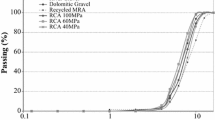Conclusions
-
1.
The use of unheated coarse aggregates in concrete is permissible with respect to heat-balance conditions in the majority of cases, even in regions of the Far North.
-
2.
The use of unheated coarse aggregates under construction conditions is possible if there is no danger of their freezing together with loss of granular properties. These requirements are met to the maximum degree: a) in regions with a limited amount of precipitation, stable air temperatures during the winter, and minimum number of transitions of the air temperature through 0°; b) at construction sites with local quarries and crushing-grading and concrete plants operating in close proximity with maximally limited intermediate stockpiles of aggregates.
-
3.
The use of unheated coarse aggregates under construction conditions should not be allowed if there is the danger of freezing together of the aggregates with their loss of granular properties. It is necessary to provide for the possibility of thawing coarse aggregates by a simplified one-stage scheme with heating to 3–5°C.
-
4.
In the case where there is the danger of freezing together of only the fine sandy gravel (rubble), these fractions can be thawed and used with the other fractions of coarse aggregate without heat treatment.
-
5.
During curing of the concrete the danger of an ice surfacing forming on the outer surfaces of grains up to 120 mm in size is eliminated if a positive temperature of the concrete mix is provided at the outlet to the mixer (mean volume temperature) and when arriving at the block for placement.
-
6.
The qualitative characteristics of the coarse-aggregate concrete with grain sizes to 120 mm, natural content to 1.5%, and temperature to minus 25–30°C with heating of the sand and water to temperatures determined by the conditions of the overall heat balance are not inferior to those for concrete prepared according to the existing winter technology with heat treatment of all components of the concrete mix except the cement.
-
7.
When using unheated coarse aggregates, heating of the sand in fluidized-bed and air-flow devices or air-spout dryers can be considered the most promising methods of heat treatment of the sand, providing it with a stable temperature and water content.
There presently exist real prerequisites for introducing at many construction sites the technology of preparing concrete with unheated coarse aggregates, which will greatly simplify the concrete plant and reduce investments, operating costs, and labor consumption at on many concreting sites.
Similar content being viewed by others
Literature Cited
G. D. Petrov, Concrete Plants at Large Construction Projects [in Russian], Gidroénergoizdat, Moscow (1960).
G. V. Bryukhanov, M. A. Sadovich, and B. V. Shaikin, “Special characteristics of concrete preparation at the Ust'-Ilim hydroelectric plant,” Gidrotekh. Stroitel'., No. 1 (1973).
G. L. Gershanovich, “Winter grading of aggregates at the Bratsk hydroelectric station,” Gidrotekh. Stroitel'., No. 2 (1963).
M. I. Brusser, “Kinetics of the water saturation of concrete,” in: Transactions of the Joint Conferences on Hydraulic Engineering [in Russian], No. 68 (1974).
A. R. Mokrushin, “Heating of concrete aggregates at hydraulic construction projects in regions with especially rigorous climatic conditions,” in: Transactions of the Joint Conferences on Hydraulic Engineering [in Russian], No. 78 (1973).
Additional information
Deceased
Translated from Gidrotekhnicheskoe Stroitel'stvo, No. 2, pp. 15–20, February, 1976.
Rights and permissions
About this article
Cite this article
Petrov, G.D., Uzhenkov, E.Y. Investigation of winter concrete made with unheated aggregates. Hydrotechnical Construction 10, 131–138 (1976). https://doi.org/10.1007/BF02406480
Issue Date:
DOI: https://doi.org/10.1007/BF02406480




